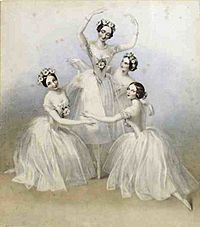Pas de Quatre (Perrot) facts for kids
Quick facts for kids Pas de Quatre |
|
|---|---|

Lithograph by A. E. Chalon:
Carlotta Grisi (left), Marie Taglioni (center), Lucille Grahn (right back), and Fanny Cerrito (right front) in the Perrot / Pugni Pas de Quatre, London, 1845 |
|
| Choreographed by | Jules Perrot |
| Composed by | Cesare Pugni |
| Date of premiere | 12 July 1845 |
| Place of premiere | Her Majesty's Theatre, London, U.K. |
| Created for | Lucile Grahn, Carlotta Grisi, Fanny Cerrito, and Marie Taglioni |
| Genre | Romantic ballet |
| Type | ballet divertissement |
Pas de Quatre is a famous short ballet piece. It was created by Jules Perrot in 1845. The music for it was written by Cesare Pugni. This ballet was first performed in London and caused a huge stir.
The reason it was so special was that it brought together four of the greatest ballerinas of that time. These dancers were Lucile Grahn, Carlotta Grisi, Fanny Cerrito, and Marie Taglioni. Imagine seeing all these stars on one stage! Pas de Quatre showed off the beautiful style of Romantic ballet. The dancers moved with grace, lightness, and perfect balance. The steps in the ballet require many different classical ballet skills. These include slow, graceful movements (adagio), quick small steps (petite allegro), big jumps (grand allegro), and fast footwork. The dancers also use elegant arm movements that are a key part of Pas de Quatre. Each ballerina has her own special dance part, called a variation. These variations were made to show off each dancer's best skills. They are performed one after another, with all the ballerinas dancing together at the beginning and end.
History of Pas de Quatre
The four ballerinas danced together only four times. To avoid arguments, they appeared on stage in order of their age, from youngest to oldest. Queen Victoria and Prince Albert even watched one of these special performances on July 17, 1845.
Anton Dolin's Version
About 100 years later, in 1941, a new version of Pas de Quatre was created. This version was staged by the choreographer Anton Dolin. He chose new dancers to play the roles of the original ballerinas. These dancers were Nathalie Krassovska as Lucile Grahn, Mia Slavenska as Carlotta Grisi, Alexandra Danilova as Fanny Cerrito, and Alicia Markova as Marie Taglioni. Since then, many ballet companies around the world have performed Dolin's version.
The special rights to perform Dolin's Pas de Quatre were given to two dancers, Belinda Wright and Jelko Yuresha. They were husband and wife and had worked with Dolin for many years. This means that no one can perform, record, or stage Dolin's Pas de Quatre without their permission.
The Music for the Ballet
The first music for Pas de Quatre was written by Cesare Pugni. This original music was only used for the four performances in July 1845. After that, the ballet was not performed for many years.
Pugni's music was first published as a piano version. The original orchestral music score is kept in a French archive. When Anton Dolin created his new version, he used a new orchestral arrangement. This was prepared by composer Leighton Lucas from Pugni's original piano music. Since then, other composers like William McDermott and Daniel Stirn have also created their own orchestral versions of the music.
See also
 In Spanish: Pas de quatre (Perrot) para niños
In Spanish: Pas de quatre (Perrot) para niños

